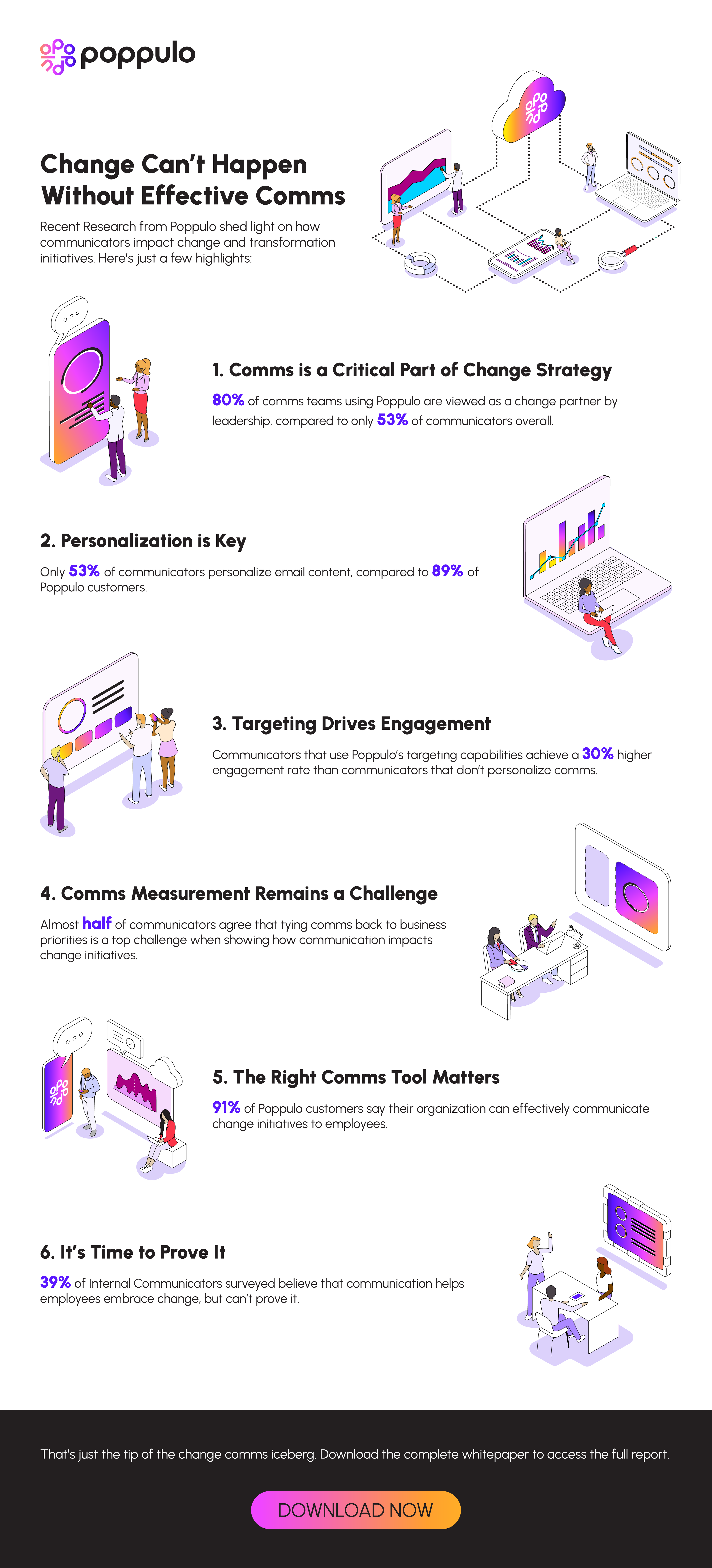As the saying goes, the only constant in life is change. The same is true for the business world—yet organizational change frequently encounters pushback from employees.
According to Gartner, the average number of enterprise changes increased 5x from 2016 to 2022. But the workforce is change-fatigued—with employees’ willingness to support change dropping from 74% in 2016 to just 43% in 2022.
What drives employee resistance to change, and how can effective communication bridge the gap?
With the help of Censuswide, we surveyed over 1,000 communicators to find out how they feel about organizational change, and presented the results in our recent webinar: The Change Opportunity: How IC Fuels Organizational Success. During the webinar, Heather Bicknell, Product Marketing Director at Poppulo, shared the key results from the change comms survey, and Ethan McCarty, Founder & CEO at Integral, offered five strategies for supporting employees through change. Let’s dive into the key takeaways.
Why Change is Challenging for Employees
There’s a growing gap between the frequency of enterprise changes and the support needed from employees to make transformation possible. Research from Integral shows that only 63% of employees believe their employer actually considers employees when making decisions—leaving 37% to believe that their leaders don’t consider their needs and perspectives when making strategic decisions. And almost a third of employees are concerned that new digital tools in the workplace will put their jobs at risk.
It's clear that employees don’t feel great about change—but what are some of the top reasons for resistance?
- Fear of the unknown: Fear of losing job, gaining more responsibility, loss of colleagues and tools, etc.
- Poor communication: Lack of transparency of clarity in the way change is communicated to employees
- Lack of trust in leadership: Lack of trust in leaders to successfully accomplish change
- Lack of support & resources: Limited access to information surrounding the change and reason behind it
Thankfully, there is an answer, and one that highlights just how critical internal comms are for businesses today. According to McKinsey, effective communication is the number one driver of change today. Organizations are 4.4x when they communicate the day-to-day employee impact of change, and 8x more successful when leaders communicate openly and across the company about transformational progress.
We know the impact effective communication has on change initiatives, but let’s dig deeper into how communicators are tackling change management today, and what factors were most important for driving successful change.
Poppulo’s Change Comms Survey Results
We collected responses from over 1,000 professional communicators at mid and large-sized organizations between the US and UK to find out how they feel about change in 2024. To access the full results of the survey and see the results broken down by organization size, level of employment, workforce composition, and more, download our whitepaper, Navigating Change: How Internal Communication Impacts the Success of Organizational Transformation.
Download Our Change Communications Survey Whitepaper
5 Strategies for Supporting Employees Through Change
- Listen to Employees
Find out what challenges and opportunities exist in the current environment through surveys, polls, focus groups, and two-way dialogue.
- Segment Your Audience
Identify how attitudes, perceptions, and needs vary by segment, such as location, role, level, work style, and more.
- Tailor Messaging to Fit the Needs of Each Audience
Determine what messages are relevant for different segments of your audience, and whether you should include a mix of local and global content, or experiment with who the messaging is coming from.
- Leverage the Right Channels
Identify which channels maximize the reach of your comms, and which facilitate information sharing vs. two-way dialogue. Some key channels to consider include email, digital signage, social channels, events, and company Intranet.
- Connect Your Measurement to Outcomes
Measure your comms to figure out how they’re performing and what actions you’re seeing as a result. Some metrics to consider include, reach, engagement, sentiment, qualitative feedback, and change outcomes.
These are just a few strategies to help get started on the change journey, but we have a lot more to offer. Check out Poppulo’s Change Communicators Toolbox for all of our change comms resources, including access to our change webinar series and our Ultimate Guide to Change Communication.
The best on communications delivered weekly to your inbox.

More posts by Christine Kendall
Content Marketing Manager, Poppulo







